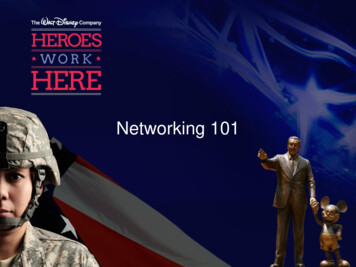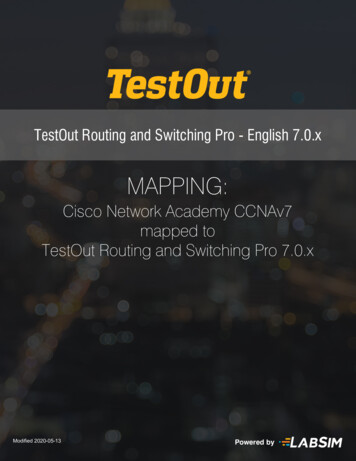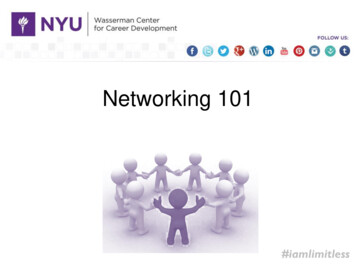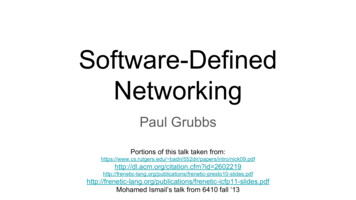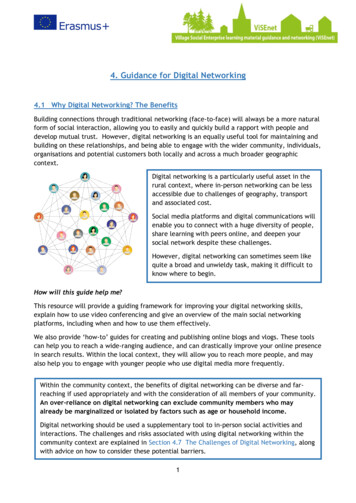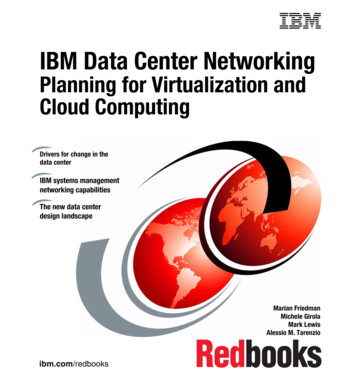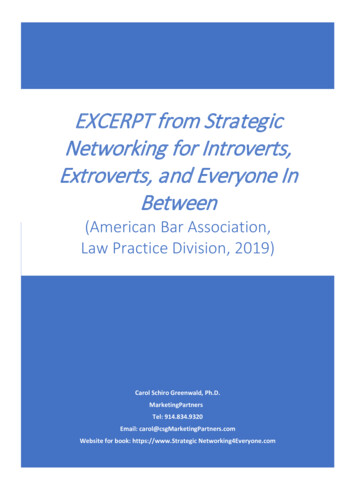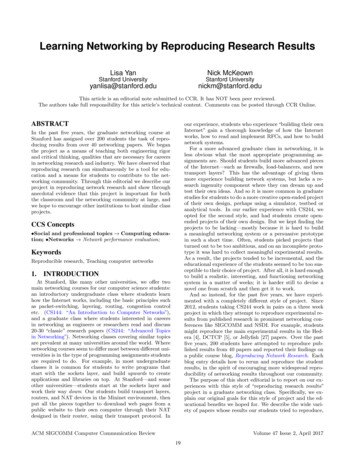
Transcription
Learning Networking by Reproducing Research ResultsLisa YanNick McKeownStanford UniversityStanford is article is an editorial note submitted to CCR. It has NOT been peer reviewed.The authors take full responsibility for this article’s technical content. Comments can be posted through CCR Online.ABSTRACTour experience, students who experience “building their ownInternet” gain a thorough knowledge of how the Internetworks, how to read and implement RFCs, and how to buildnetwork systems.For a more advanced graduate class in networking, it isless obvious what the most appropriate programming assignments are. Should students build more advanced piecesof the Internet—such as firewalls, load-balancers, and newtransport layers? This has the advantage of giving themmore experience building network systems, but lacks a research ingenuity component where they can dream up andtest their own ideas. And so it is more common in graduatestudies for students to do a more creative open-ended projectof their own design, perhaps using a simulator, testbed oranalytical tools. In our earlier experience with CS244, weopted for the second style, and had students create openended projects of their own design. But we kept finding theprojects to be lacking—mostly because it is hard to builda meaningful networking system or a persuasive prototypein such a short time. Often, students picked projects thatturned out to be too ambitious, and on an incomplete prototype it was hard to collect meaningful experimental results.As a result, the projects tended to be incremental, and theeducational experience of the students seemed to be too susceptible to their choice of project. After all, it is hard enoughto build a realistic, interesting, and functioning networkingsystem in a matter of weeks; it is harder still to devise anovel one from scratch and then get it to work.And so instead, for the past five years, we have experimented with a completely di erent style of project. Since2012, students taking CS244 work in pairs on a three weekproject in which they attempt to reproduce experimental results from published research in prominent networking conferences like SIGCOMM and NSDI. For example, studentsmight reproduce the main experimental results in the Hedera [4], DCTCP [5], or Jellyfish [27] papers. Over the pastfive years, 200 students have attempted to reproduce published results from 40 papers and reported their findings ona public course blog, Reproducing Network Research. Eachblog entry details how to rerun and reproduce the studentresults, in the spirit of encouraging more widespread reproducibility of networking results throughout our community.The purpose of this short editorial is to report on our experiences with this style of “reproducing research results”project in a graduate networking class. Specifically, we explain our original goals for this style of project and the educational benefits we hoped for. We describe the wide variety of papers whose results our students tried to reproduce,In the past five years, the graduate networking course atStanford has assigned over 200 students the task of reproducing results from over 40 networking papers. We beganthe project as a means of teaching both engineering rigorand critical thinking, qualities that are necessary for careersin networking research and industry. We have observed thatreproducing research can simultaneously be a tool for education and a means for students to contribute to the networking community. Through this editorial we describe ourproject in reproducing network research and show throughanecdotal evidence that this project is important for boththe classroom and the networking community at large, andwe hope to encourage other institutions to host similar classprojects.CCS Concepts Social and professional topics ! Computing education; Networks ! Network performance evaluation;KeywordsReproducible research, Teaching computer networks1.INTRODUCTIONAt Stanford, like many other universities, we o er twomain networking courses for our computer science students:an introductory undergraduate class where students learnhow the Internet works, including the basic principles suchas packet-switching, layering, routing, congestion controletc. (CS144: “An Introduction to Computer Networks”),and a graduate class where students interested in careersin networking as engineers or researchers read and discuss20-30 “classic” research papers (CS244: “Advanced Topicsin Networking”). Networking classes covering similar topicsare prevalent at many universities around the world. Wherenetworking courses seem to di er most between di erent universities is in the type of programming assignments studentsare required to do. For example, in most undergraduateclasses it is common for students to write programs thatstart with the sockets layer, and build upwards to createapplications and libraries on top. At Stanford—and someother universities—students start at the sockets layer andwork their way down: Our students build transport layers,routers, and NAT devices in the Mininet environment, thenput all the pieces together to download web pages from apublic website to their own computer through their NATdesigned in their router, using their transport protocol. InACM SIGCOMM Computer Communication ReviewVolume 47 Issue 2, April 201719
along with a study of how well they did. We found that alarge majority of students were able to successfully recreate the experiment and generate comparable results, with asmall fraction unable to. In some cases, they ran into technical difficulties, while in others they were able to make astrong case that the original research contained errors. Inall cases, we encouraged students to contact and work withthe original authors, which turns out to be a major component of the educational experience for the students. Finally,we report on the educational impact of this project basedon interviews from students relating their experiences. Wepresent these findings so that you, the reader, can determine whether this type of project might be useful in yourgraduate networking classes too.2.Day 1Deliverable: project proposals for primary andsecondary choiceDay 3TAs assign projects with minimal overlap.Students contact authors with instructor help.Weekly, 15-min TA-student meetings on project.Day 14Deliverable: intermediate report with structure offinal report, outline of next stepsWeekly, 15-min TA-student meetings on project.WHY WE CHOSE REPRODUCIBILITYOur primary over-arching reason for asking graduate students to reproduce published research results is the educational value it brings. Our approach is very similar to howhigh-school and college students study science worldwide:in tandem with attending lectures and reading textbooks,they reinforce their learning by repeating well-known experiments in the lab. Although the students know and anticipate the experimental outcomes prior to entering the lab, itis widely agreed that the process of reproducing experimentsgives students a much deeper understanding of the underlying concepts. Our main goal for adapting this scientificapproach to our networking class is for students to obtain adetailed, in-depth understanding of a significant paper, itskey ideas, and its key results.The second biggest benefit is the experience our studentsget building—or recreating—the experiment for themselves.In the science community, reproducing research generallymeans repeating the experiment and reproducing resultsidentical to the original. In our class, however, studentsspend much more time building and recreating the originalexperiment than they do collecting and verifying the results.In our experience, recreating the experiments is the mosttime-intensive and most fulfilling aspect of the project forour students; achieving identical results is something theymay (or may not) do at the end, after their experiment isworking. We therefore distinguish the initial step of recreating the experimental infrastructure from the second step ofcollecting and possibly reproducing the same results as theoriginal authors. We rate students highly if they successfullyrecreate the experiment, regardless of whether they can reproduce the same results. In fact, we find that students learna huge amount when their experiments yield di erent resultsfrom the original research: they must figure out where thediscrepancies lie and discern if there are unstated assumptions or inaccuracies in their own results or the publishedresults. This is a fascinating and educational experience,and often a good lesson in diplomacy.There are many additional benefits to repeating experiments: if students spend a lot of time studying and repeatinga published experiment, it leads them to ask “meta” questions about the paper: Why did the researchers pose theproblem they did? Why did they use or build a particularprototype or simulator, and why did they collect a specificset of results? These questions allow students to get intothe heads of what the researchers were thinking about whenthey did the research, much more than by simply readingthe paper. By going through the process of reproducing re-Day 23Deliverable: final blog post, public source coderepository, steps for reproducingDay 28In-class presentations of select projectsDay 31Peer validation of another student group’s projectFigure 1: Student project timeline.sults, students gain a deeper understanding of the researchprocess.The project also gives students the necessary experienceof building a novel prototype, system, emulator or simulator, without necessarily having to be the first one to comeup with the idea and try it out. At some level, they alreadyknow the idea was a good one: it is practical and has somevalue, at least enough to warrant publication at a top conference. They are not taking on as big a risk as they wouldwhen coming up with their own research problem. As a result, we can expect far more students to obtain satisfactoryresults. With a high degree of confidence, they already knowinteresting results are possible, which encourages them (orperhaps goads them via peer pressure) to complete the work.We also believe it instills an important principle in ourfuture researchers that their research results should be reproducible by others, whenever possible. If results can bereproduced then it is more likely that industry will adoptthem, or that other researchers will build upon them - perhaps by directly reusing the experiment’s software. There isa growing movement in systems research to make our resultsmore easily reproduced by others [7, 8, 16]. Our studentsadd to the corpus of reproduced results by providing a simple, packaged reproduction experiment; in this manner, theycan encourage the whole community to make results morereproducible by others.All of these reasons seem valuable to graduate studentspreparing for a career in networking systems research or inindustry.3.THE REPRODUCIBILITY PROJECTOur students work in pairs and have three weeks (outof a ten-week course) to complete the assignment. Theythen have an additional week to verify each other’s projectsand give in-class presentations. Figure 1 shows the projecttimeline; we describe the main steps of the project below.Select a project. Each student pair starts by choosing afigure or table from a research paper of interest that is integral to the paper’s motivation or claims. This may includecomparing the performance of an algorithm against existingalgorithms, demonstrating a metric’s usefulness, or record-ACM SIGCOMM Computer Communication ReviewVolume 47 Issue 2, April 201720
ing important traffic and workload data. To get the studentsstarted, we provide a list of suggested conferences and research publications that we think make good examples, andwe encourage students to choose more recent works, or onesthat have not yet been attempted by students in previouscourse o erings. At Stanford we have had students successfully reproduce results ranging from widely cited paperssuch as Hedera [4] and DCTCP [5] to traditional paperslike RED [13], to cutting-edge, as-yet unpublished work likeSPDY [1].Course offering201220132014201520160510152025Number of student groupsChoose a method of reproduction. We encourage students to use either the Mininet [22] or Mahimahi [23] emulation systems for their experiment platform, largely because they are most familiar to the instructors. Mininet isbest suited for multi-node topologies, whereas Mahimahi isgood when modifying and testing congestion control protocols running over a single link. While we generally preferstudents to use emulators—as emulators exhibit more realistic network characteristics, such as real-time, live traffichandling for a given node topology [16]—we also encouragethe use of simulators, such as ns-3 [3], if the scale or performance is beyond the reach of an emulator. We provide allstudents with computing resources on Amazon Web Service(AWS) Elastic Compute Cloud (EC2) to run their experiments, making it easier for others to replicate.Unable to recreate experimentAble to recreate experimentFigure 2: The number of successful student projects, listedby course year. Success is defined as being able to recreatethe experiment and generate comparable results.original research paper, reviewing our students’ work, andby new researchers looking for ideas or ways to get startedin their own research (see Section 5 for anecdotes).We verify the results in every blog post using peer validation: every student group is required to replicate theresults of another student group. The reproduction e ortis required to be an easy, two-step process: (1) downloadand install any code, and (2) click “run.” All code must beavailable in public code repositories. The students thereforeprovide all their software source code, experimental data,the means to generate the results, and a detailed interpretation of their results to other researchers. They also uploada public snapshot of their Amazon EC2 machine for easyinstallation and setup. The public code repositories haveproven beneficial for other researchers, who contact the students through the blog in order to use these selected researchprojects as a base of inspiration or comparison for their ownwork. These requirements ensure others can build on ourstudents’ results, furthering our goal to make more networksystems research reproducible.Contact original authors. After deciding which experiments to run, we help the students contact the authors.Opening up this communication channel between studentsand researchers has two main benefits: the first is for the student, who now has a primary source to contact regarding thetools, setup, workload and use-cases of the given experimentor research tool. The second is for the researcher, who is nowaware that his or her work is being analyzed critically; uponcompletion of the students’ experiments, the researcher willhave additional feedback on the benefits, caveats, and persistence of his or her findings. We discuss anecdotal evidenceon the importance of this communication later in Section 5.Work with instructors and peers. Recreating other researchers’ work is non-trivial; it is essential that course sta support the students throughout their task. In our courseof 40 students we were fortunate to have two teaching assistants, who met every group every week, to check-in andprovide guidance. In some cases, we were able to pair up students with graduate student mentors whose expertise overlapped with the target research project. We also require ashort intermediate report in the middle of the assignmentwhere students describe what they have done so far, andwhat they plan to do for the remaining time. This allowsinstructors to give feedback to the students on the feasibilityof any remaining steps.The course ends with students giving short talks abouttheir projects. Students present the main highlights of theirreproduced research to the whole class for ten minutes, followed by a short Q&A session.4.OVERVIEW OF REPRODUCTIONRESULTSSince 2012, we have seen over a hundred student projectsin reproducing networking research. Most have been successful—and a few have not—but overall we have observedthat students walk away with the confidence that they canovercome difficult, technical challenges in networking research. In this section, we summarize our experiences inmore detail.Figure 2 reports how many student projects successfullyrecreated research experiments each year, where success isdefined as being able to recreate the experiment and generate a result comparable to the original research. The graphshows that a small number of projects each year consistentlyfall into the “unsuccessful” category, often because studentscan be over-ambitious: they attempt reproductions in emulators unsuitable for the project, they cannot find the righttools in time, or they overestimate their abilities to build asystem from scratch. There are a few other reasons that wediscuss later (Section 4.1).The most popular research papers selected by students areshown in Figure 3. These papers were most likely selectedbecause of their ease of setup in the emulators we chose;Write a public blog. Each group is required to document their project—successful or unsuccessful—and any additional findings or conclusions in a public blog post on thecourse’s Reproducing Network Research blog. The blog entrymust contain all the code and workload in order for someoneelse to easily repeat the experiments too. And many do; overthe years, our website has been visited by the authors of theACM SIGCOMM Computer Communication ReviewVolume 47 Issue 2, April 201721
PublicationTCP Opt-ack Attack [26]Jellyfish [27]Init CWND [12]TCP Fast Open [24]Low-rate TCP DoS [21]MPTCP [25]RCP [11]DCTCP [5]HTTP-based Video Streaming [18]DCell [15]Hedera [4]Mosh [28]PCC [10]pFabric [6]Sprout ystem source codeOpen-sourceOpen-source butout-of-dateOpen-source butinconsistent w/resultsContacted authorBinary availableStudent-createdNot neededCourse offering20132014201520161015202530Number of student groupsmininetmahimahins2ns3emulab12199A summary of the availability of code and data for each ofthe forty unique research papers studied by students in ourcourse is shown in Figure 5. Occasionally, the research paperlacked key numbers or details about the experiment environment, so students had to reason about additional featuresand generate their own network workloads. Sometimes, thesystem source code was open-sourced, but upon further inspection the students found the results of the open-sourcedcode inconsistent with those published in the paper, andthey had to resort to developing the system from scratch.Despite these setbacks, we have found that students whodesigned their own experiments gained expert intuition inhow their system operated and were thus often very successful in recreating experiments.If they are running experiments in an emulator, studentstypically need to scale the experiment (size or data-rate) sothe emulate can keep up. For example, some research resultsare gathered in large datacenters with hundreds of nodes andlink speed of 10-100Gb/s. A typical emulator can handle upto tens or hundreds of nodes, with links running at 1-10Gb/sat most.201256Workload generationOpen-source9Sufficient details17in paperStudent-created14Figure 5: Availability of source code and workload generation code for each paper.Figure 3: The 15 most popular research papers selected forstudent projects.012otherFigure 4: Emulator and simulator platforms used by students for reproducing research, listed by course year.4.1Project successesStudents have varying levels of success with recreatingresearch results. Due to the complexity of the project, it isan accomplishment in itself for students to simply get thesystem up and running. We therefore have defined successin this project based on three criteria:most of them are variations of TCP, and some of them areapplication-based or topology-based. Some experiments aremore difficult to recreate than others, even if they are fromthe same research paper; this accounts for some of the unsuccessful projects in Figure 3. Other students are moreambitious in their project, opting to port an existing experiment to a di erent emulator, which often leads to moredifficulties.Figure 4 summarizes the variety of emulators and simulators that students have used. While we encouraged theuse of Mininet [22] and Mahimahi [23], some groups usedns-2 [19], ns-3 [3], and Emulab [17] instead, usually becausethe original research used these platforms too, making iteasier for the students to re-use existing open source code.In some cases, students who started out using simulatorsported their experiments to an emulator in order to get realtime, realistic results, all within the three week time span ofthe project.1. Are the students able to recreate the experiment?2. Are the student-generated results and the original results similar in shape?3. Can the students justify any discrepancies in results?Sometimes, students are able to recreate the original workalmost perfectly, subject to scaling or computation resourcelimits. One student group replicated a TCP opt-ack attack [26], where the task was to create a TCP attackersending optimistic acknowledgements (opt-acks) to multiplevictims over a bottleneck link, generating enough traffic tocause congestion collapse (Figure 6a). Even though the original experiment was simulated in ns-2, the students decidedto emulate the experiment in Mininet by first designing aMininet topology and then programming their own opt-ackattacker in Python. They also had to adjust IP table andARP cache settings on Linux in order to send raw sockettraffic on an Amazon EC2 instance. Finally, they were ableto produce Figure 6b, which shows very similar traffic patterns to the original, simulated experiment. They explaineddiscrepancies in their results; in particular, they were unableAvailability of research code. Running an experimenttypically requires two components: the system and the experiment workload. Students often obtain both from theauthors, or they find them in online, open-source repositories; sometimes, they need to implement it themselves basedon the in-depth description in a paper or technical report.Overall, we have found the availability of the original experimental code and workload plays a large part in determiningthe likely success of reproducing results.ACM SIGCOMM Computer Communication ReviewVolume 47 Issue 2, April 201722
cherJump-start newexperimentsSimulator/emulatordeveloperTool feedback/improvement(a) .Figure 7: Influences of student project on other parts ofnetworking community.and create a new environment, there is no way to ascertain the truths or possibilities of the results. On the otherhand, if the original authors had used an emulator, such asMininet, maybe they could’ve packaged it. . . so that otherpeople [could use that setup for] experiments.”Reproducing research (un)successfully. There are alsocases where students are not able to achieve all three criteria of success. Sometimes, there are limitations in theemulation environment: while setting up an experiment forQJump [14], a student pair had to engineer multiple queueing disciplines in Mininet, a feature that did not come outof-box with the emulator. Another group reported issuesconfiguring POX [2] and Mininet in tandem when trying torecreate the switch controller topology in DCell [15]. Othertimes, the age of a paper can a ect modern reproductions.A group attempted to replicate the observation that REDmaintains significantly higher throughput than Drop Tailqueueing at low queue sizes [13]. However, they found thatin most cases, Drop Tail and RED performed equally well.After discussion with a commenter it seems that the mostlikely reason is the underlying TCP mechanism, which inmodern times has evolved considerably, perhaps reducingthe relative benefits of these two queueing mechanisms.Students are also occasionally too ambitious: A pair ofstudents tried to implement the rate-based adaptive videostreaming of FastMPC [30] in a popular open-source mediaplayer. They began the project well by finding the samevideo and wireless traces used in the original experiment.However, they ran out of time trying to find an appropriateoptimizer that could solve the mixed linear programmingmodel for FastMPC. In retrospect, situations like these couldhave be avoided with timely interventions by teaching sta ,who can help students find appropriate tools, or scale downthe scope of their project.(b)Figure 6: A successfully recreated experiment: (a) authorresults (Figure 7 in the original paper [26]) and (b) studentrecreated results for maximum traffic induced by a TCPopt-ack attacker over time for multiple connected victims.to recreate the attack for more than 64 victims due to performance limitations on an emulator for even the largest Amazon EC2 instance with the highest compute power. Theyalso noted that their emulated results had a more jaggedshape than the original results, perhaps due to artifacts inmeasurement. Overall, because the students were able togenerate emulated results very similar to the original paper’s simulations—and gave sufficient justification for anydi erences—we consider the student project a success.Occasionally, students identify discrepancies with the original results for other reasons, despite high confidence in theirown recreation of the experiment. For example, one studentgroup compared the performance of ECMP and Hedera [4]on both a hardware testbed and on Mininet. After contacting the original authors, the students reran the benchmarktests and were able to exactly recreate the performance characteristics of Hedera in both the hardware and emulated environments. However, the students consistently found theirown hardware ECMP performed significantly better thanthe original paper’s ECMP results. The students reran theECMP results with spanning tree enabled (something youwould not expect in a data-center) and discovered that theresulting, worse performance was identical to the results inthe paper. They subsequently contacted the authors to seeif they could verify their findings, but the original testbedhad been torn down years ago, and there was no way to rerun the experiment for additional verification [16]. As oneof the students reflected, “when you create a new testbed4.2Participating in the communityAn unexpected outcome of this project is an increased roleof students in the networking research community. Whiledesigning and running the experiments, students had to interact with the original authors, new researchers who cameacross our course blog, and even developers of the emulatorsor simulators. We believe the benefits of these interactionsgo both ways; the networking community at large can alsobenefit from these student research reproduction projects.We summarize the interactions in Figure 7. Original re-ACM SIGCOMM Computer Communication ReviewVolume 47 Issue 2, April 201723
searchers can share their experiences with students to aid inthe reproduction e ort, and students can give feedback onhow well the system works in di erent environments. Newresearchers can use the blog post and public repositoriespublished by students to jump-start new experiments in newresearch.they then moved on to extend the author’s work to showresults for three Wifi access points in a three-dimensionalgraph.Understanding cutting-edge research. Senior studentsare also interested in learning cutting-edge research that willhelp them generate ideas for their own future projects. Reproducing research on a short timeline is a great way tointeract with other researchers and understand how to usecommon tools without needing to expend the rigorous engineering e orts required to achieve research-level systemmastery. A pair of second-year graduate students were inspired to reproduce the results from QJump [14] due to bothof their research interests in networked systems. One of thestudents had attended NSDI 2015 and had heard the authors’ presentation in person; at the time, her own researchwas focused on reducing the latency of networked memoryin datacenters, and she felt that QJump was an innovativemethod for scheduling datacenter traffic. As she recounted,“You could tell from their paper that they really tried tomake everything reproducible.” The researchers had published methods for recreating experiment workloads for allfigures in their NSDI publication.However, she noted that they ultimately did not use theauthors’ work directly: “Their assumption was that [people]would reproduce the results in an actual datacenter, whereaswe did the emulation in Mininet. In the end, we did not usetheir scripts directly, but it was nice to see that the authorswere enthusiastic to have their work reproduced.” This pairof students contacted the authors throughout the project toreconcile scaling and timing di erences that arose from usingan emulated environment in place of a datacenter and werefinally successful in recreating the experiments in Mininet.The other student commented that the original authors even“tweeted about [our final blog post], actually.” The overall reproduction e ort helped the students understand on a deeplevel what types of traffic control schemes work in datacenters. The first student mentioned that after the course, sheimplemented a scheduler for her research similar to one fromthe project, “which is something that I wouldn’t have doneif [I had just read] the paper.”Interacting with platform developers. Simulator andemulator developers can also use student projects by treating them as use cases for evaluating their platform utility. Ifthe platform is still in development, these student projec
etc. (CS144: "An Introduction to Computer Networks"), and a graduate class where students interested in careers in networking as engineers or researchers read and discuss 20-30 "classic" research papers (CS244: "Advanced Topics in Networking"). Networking classes covering similar topics are prevalent at many universities around the .

